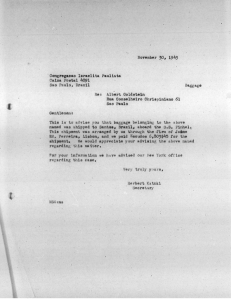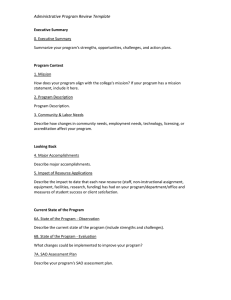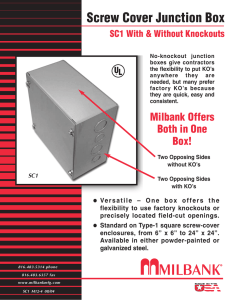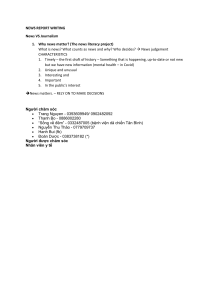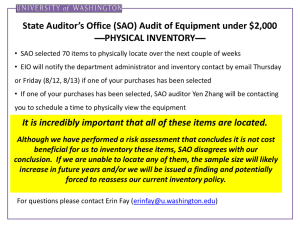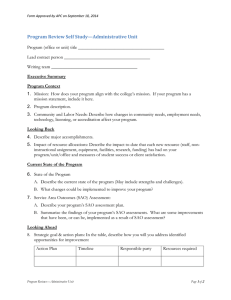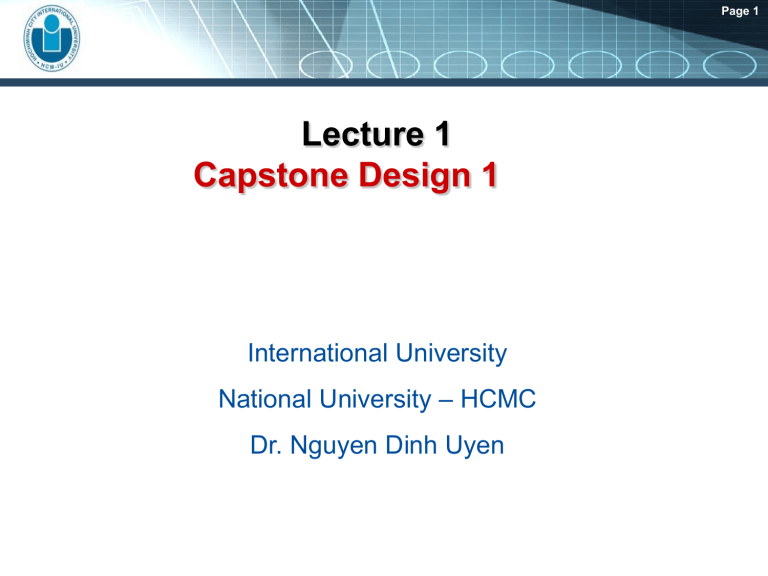
Page 1 Lecture 1 Capstone Design 1 International University National University – HCMC Dr. Nguyen Dinh Uyen Page 2 Capstone Design 1 Course Class Instructors: Dr. Nguyen Dinh Uyen hours: Tuesday 8:00-10:30 PM Text book: None TA: Page 3 Personal Background Lived and worked in the US since 1981 Received Ph.D. from Catholic University of America in 2001 Taught at CUA from 1998-2003 Worked for NASA from 1989-1995 Consulted for US government and various companies: Titan, L3, and Raytheon, from 1995-2008 Current: Teaching at the International University Page 4 Capstone Design 1 Grading Policy Capstone professor Attendance (fail the class if missing >3 classes) (30%) Mid-term exam, draft of the proposal, and group presentation (30%) Advised professor Participation + group work Final group presentation and report (40%) Office hours: Monday 8-10:30AM, Room 108-A2 Contact (08) information: nduyen@hcmiu.edu.vn , 372-44270 Ext.3231 Lecture Notes and HW: BLACKBOARD Handouts Page 5 Capstone Design 1 Class Room Policy No Talking No Cell Phone during class After 15 minutes class room will be closed Quizzes will be given without notice Attendance is required Students missing 3 classes will not be allowed to take the final exam and will fail the class Page 6 Capstone Design 1 Objectives: This course is an introduction to engineering design process. Two semesters of lecture and design. Students will work in multidisciplinary teams to complete an approved engineering design projects Students will learn to define a problem, conduct research to propose the solutions, determine the realistic constraints, prepare project scheduling, and create a planned budget for the project. Students will complete a proposal of the design, which they will The work will be performed as a team in accordance with ABET requirements. Each team is comprised of two to four students Students will be assigned an advisor Page 7 TOPICS Design Process Presentations: Issues Problem statement Literature Review Proposed methodology Preliminary Results (Advised Write Professor will help) a Senior/Thesis Report Draft at Midterm Proposal at Final Two Presentations Midterm: Present proposed idea Final: Present the solution and preliminary data Page 8 Blackboard • We will use Blackboard and email to communicate • Course information and materials will be posted on Blackboard • http://bb.hcmiu.edu.vn:8080/ Account: Your ID Password: ? Page 9 Hubble Space Telescope NASA 1989 – 1996 - Write code in Fortran Page 10 Affordable Weapon System X-Craft Future Combat System Page 11 Graduate students: - Antenna for RTLS - Antenna for 5G Page 12 10cm 15cm 20cm Graduate students: - Affect of cellular phone with the human male’s productive system. Page 13 Graduate student: - Level of brain injury during the motorbike accident Page 14 Graduate students: - Detect the eye movements to control the mouse on the computer Page 15 Tools • • • • • Matlab Arduino IDE Atrium Solidworks Circuit Board CNC 1 6 Page 16 Engineer and Engineering Design • The word engineer has Latin roots in ingeniare (i.e. “to contrive, devise”) and ingenium (i.e. “cleverness”). • An engineer is a professional practitioner of engineering, who has mathematical and scientific training and can apply such knowledge, together with ingenuity, to design and build complicated products, machines, structures or systems and thus develops solutions for technical problems. • An engineering design pulls together (i.e. synthesizes) something new or arranges existing things in a new way to satisfy a recognized need of society. Engineering designs considers the limitations imposed by practicality, regulation, safety, and cost. 1 7 Page 17 Challenges of Engineering Design • • • • Creativity: creation of something that has not existed before Complexity: requires decisions on many variables and parameters Choice: requires making choices between many solutions at all levels, from basic concepts to the smallest detail Compromise: requires balancing multiple and sometimes conflicting requirements Page 18 Definition of Engineering Design Engineering design is the process of devising a system, component, or process to meet desired needs. It is a decision-making process (often iterative), in which the basic science and mathematics and engineering sciences are applied to convert resources optimally to meet a stated objective Page 19 Engineering Design Models Page 20 Capstone Design 1 Capstone Design 2 https://www.sciencebuddies.org/science-fair-projects/engineering-designprocess/engineering-design-process-steps#problem Page 21 This process can be divided up into steps, which includes: (for Capstone 1) 1. 2. 3. 4. 5. 6. 7. Identifying a need (or issue) Defining the problem (problem statement) Background research (literature review) Specify requirements Brainstorm and Evaluate multiple solution Choose a solution and Making a decision Presenting the product 1. Documentation 2. Presentation Page 22 1- Identify a need The first step of this process is the identification of a need • Engineers themselves often do not do this step of the process, but rather society discovers a need and then presents that need to the engineering firm/community • The term “need” is fairly vague, but often refers to desire or shortage of a good Page 23 Example 1 Nhận biết hoa quả 'tẩm' hóa chất Cam, lê, táo… có hóa chất bảo quản; đu đủ, chuối… có đất đèn; các loại dưa có phun hoặc tiêm thuốc… là những điều nhiều bà nội trợ vẫn bán tín bán nghi về độ xác thực của thông tin. Người bán cũng không phân biệt được Page 24 Example 2 Thịt lợn thối tiêm thuốc an thần, ngâm hóa chất thành thịt tươi. Thịt heo là món ăn quen thuộc trong bữa cơm của mỗi gia đình nhưng thật đáng lo ngại khi một số kẻ kinh doanh vô đạo đức đang tìm mọi cách "tẩm độc" thịt heo để thu lợi bất chính. Page 25 Example 3 Ngập nước ở TP.HCM: Theo các chuyên gia, trước tình hình ngập úng như hiện nay tại TP.HCM, người dân chỉ có thể học cách thích nghi nhưng không thể chịu đựng mãi. Page 26 Example 4 Một số trường học đang triển khai thi học kỳ trực tuyến sao cho vừa đánh giá đúng năng lực, vừa chống gian lận nhưng cũng không quá gây áp lực cho học sinh. Sinh viên đại học gian lận thường xuyên. Page 27 Example 5 Cộng đồng bức xúc trước những hình ảnh con trai và con dâu ngược đãi mẹ già 88 tuổi ở Tiền Giang. Nghĩ về những tình cảnh người già đang sống cô đơn giữa người thân trong ngôi nhà của mình. Ai chăm lo cho người già? Page 28 2- Define a Problem The second step of the engineering design process is defining the problem. Engineers must appropriately define the problem first in order to find an acceptable solution to it or improve it. • What is the problem or need? • Who has the problem or need? • Why is it important to solve? • Problem statement must be as specific as possible Page 29 Example 1 Background Nhận biết hoa quả 'tẩm' hóa chất Cam, lê, táo… có hóa chất bảo quản; đu đủ, chuối… có đất đèn; các loại dưa có phun hoặc tiêm thuốc… là những điều nhiều bà nội trợ vẫn bán tín bán nghi về độ xác thực của thông tin. Người bán cũng không phân biệt được Problem statement? • Lam sao tim duoc thuoc bao quan tren trai cay? • Lam sao quan ly duoc nguon goc cua trai cay? Page 30 Example 2 Background Thịt lợn thối tiêm thuốc an thần, ngâm hóa chất thành thịt tươi. Thịt heo là món ăn quen thuộc trong bữa cơm của mỗi gia đình nhưng thật đáng lo ngại khi một số kẻ kinh doanh vô đạo đức đang tìm mọi cách "tẩm độc" thịt heo để thu lợi bất chính. Problem statement: • Lam sao do duoc chat khang sinh trong thit heo? • Lam sao quan ly duoc nguon goc cua thit heo? Page 31 Example 3 Background Ngập nước ở TP.HCM: Theo các chuyên gia, trước tình hình ngập úng như hiện nay tại TP.HCM, người dân chỉ có thể học cách thích nghi nhưng không thể chịu đựng mãi. Problem statement: • Lam sao biet duoc noi nao se ngap nuoc? • Lam sao bao duoc cho nguoi di duong biet duoc cho ngap nuoc de tranh? Page 32 Example 4 Background Một số trường học đang triển khai thi học kỳ trực tuyến sao cho vừa đánh giá đúng năng lực, vừa chống gian lận nhưng cũng không quá gây áp lực cho học sinh. Sinh viên đại học gian lận thường xuyên. Problem statement: • Lam sao biet duoc sinh vien copy? • Lam sao de thi se khong giong nhau? Page 33 Example 5 Background Cộng đồng bức xúc trước những hình ảnh con trai và con dâu ngược đãi mẹ già 88 tuổi ở Tiền Giang. Nghĩ về những tình cảnh người già đang sống cô đơn giữa người thân trong ngôi nhà của mình. Ai chăm lo cho người già? Problem statement: • Lam sao giam sat duoc nguoi gia song mot minh qua IOT? • Lam sao co the giup duoc gia dinh lo cho ba me liet giuong? Page 34 3- Background Research The third step in the design process is background research • Most of a productive engineer’s time will be spent locating, applying, and transferring information • In order for an engineer to solve a problem, they first must be well acquainted with as much information possible, which in turn produce a better solution • Background research is especially important for engineering design projects, because you can learn from the experience of others rather than blunder around and repeat their mistakes. Page 35 3- Background Research Steps to perform background research: 1. Identify questions to ask about your customer. 2. Identify questions to ask about the products that already exist to solve the problem you defined. 3. Find and read the general information 4. Find and read specific scientific publications relate to your key words. Use the bibliographies and sources in everything you read to find additional sources of information. 5. Search the Internet to get information from an organization, society or online database. Page 36 Example https://www.researchgate.net/publication/330710620_Detecting_and_Ma pping_Harmful_Chemicals_in_Fruit_and_Vegetables_Using_Nanoparticl e-Enhanced_Laser-Induced_Breakdown_Spectroscopy Page 37 4- Specify Requirements Design requirements state the important characteristics that your solution must meet to succeed. One of the best ways to identify the design requirements for your solution is to analyze the concrete example of a similar, existing product, noting each of its key features. Page 38 4- Examples 1. What are the physical requirements/limits of the product you are designing? The answers to this question are your next design requirements 1. Weight < 2kg 2. Power < 2 watts 2. What are the conceptual requirements/limits of the product you are designing? Examples often include cost and the timeline of the project. 1. The product will cost 30USD to make 2. The product will be manufactured in less than 1 month Page 39 5- Brainstorm and Evaluate #1 Rule when creating alternative solutions: DON'T SETTLE FOR YOUR FIRST IDEA! Good designers try to generate as many possible solutions as they can before choosing one that they feel is the best. This creative process of developing ideas is called ideation. Methods of ideation include: 1. Examining existing solutions 2. Creating and using analogies 3. Conducting brainstorming sessions 4. Sketching and doodling Page 40 6- Choose a solution First, look at whether each possible solution met your design requirements. Consider solutions that did a much better job than others, and reject those that did not meet the requirements. Some criteria apply to virtually every design. Good designers consider these universal design criteria when choosing which possible solution to implement: Elegance Robustness Aesthetics Cost Resources Time Skill required Safety It helps to compare solutions in a decision matrix. If your requirements and solutions are relatively simple, you can sometimes just list the pros and cons for each solution. Page 41 6- Example Page 42 7- Presenting the Product 1. Documentation 1. Senior Report 2. Thesis Report 1. Abstract 2. Introduction 3. Literature Review 4. Methodology 5. Preliminary Results 6. Conclusion/Discussion 7. Future works 2. Presentation 1. Senior 2. Thesis Page 43 HW- 1 1- Create a group of 4-5 people 2- For each group, identify 2 current issues in the Vietnam or the world(agriculture, education, or social). Identify the 5 problems to be solved. Present the problem with the followings. 1. Issues: 2. Problem statements: 1.Report: voi ten cua group, table of content, list of figure, list of table. Page 44 https://www.engineeringforchange.org/siemenschallenge/?utm_source=googl e&utm_medium=adwords&utm_campaign=SiemensUSA_E4C_CPC&gclid=Cj wKCAjwkdL6BRAREiwAkiczIYRptzHGWWorR03eJL2RUuHFoSP3I_U2uvxSsoMb4RFdKqrctDaoBoC cbMQAvD_BwE

